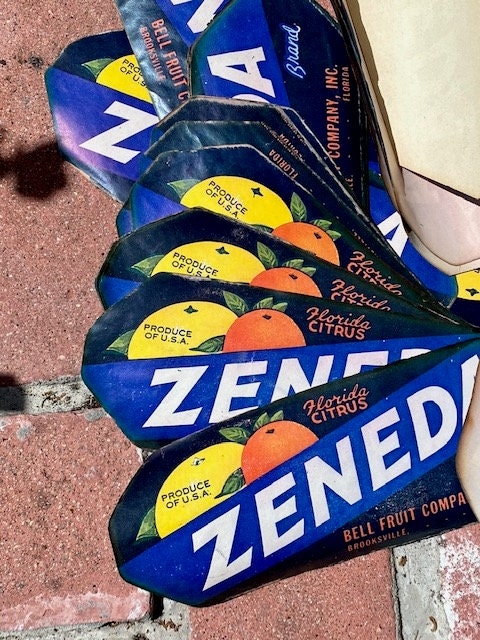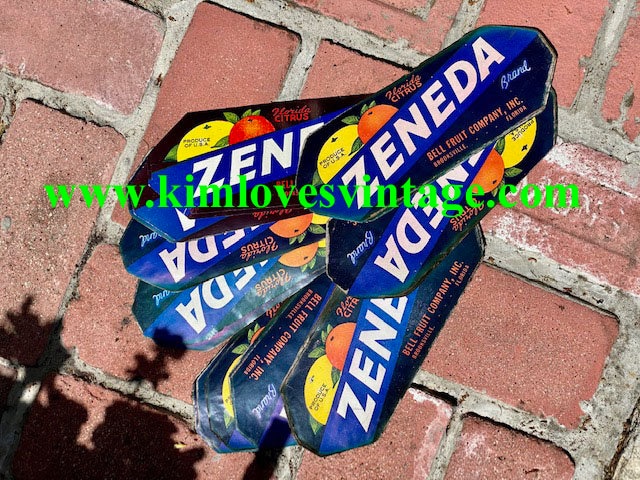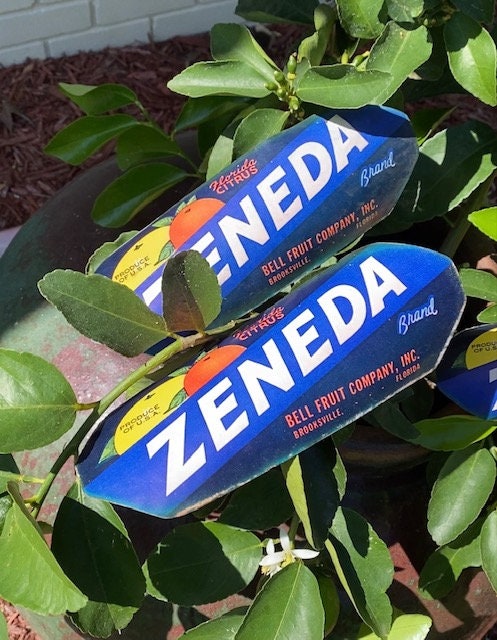



Authentic Original Vintage Fruit Crate Label Zeneda Brand, Bell Fruit Company, Inc Brooksville, Florida Salvaged from Packing House Fire
$50.00
RARE find, Zeneda Brand Florida Citrus from Bell Fruit Company, Brooksville, Florida
The Bell Fruit Company Packing House was down on Jefferson Street at the railroad track near the Seaboard Coastline Station.
I believe it burned down in the mid to late 1980's
I am a 4th generation Native Floridian.
I grew up in Brooksville and was friends with the owners and after it burned stopped by to see the site and salvaged some items from the rubble.
With permission of course...
I still have about 3 dozen Zeneda Brand Florida Citrus crate labels dug out of the ashes.
I have had these in storage since that time. When I moved last year I found them and I need to downsize.
These are Absolutely Original! Not reproductions like you see available in most shops.
The paper is very delicate as it is vintage, the lithography is brilliant.
These were a storage of Old Stock labels, most likely printed in the 1950's, possibly earlier
Florida Memory Archive dates this label to 1930-1950's
I have watermarked the photos to prevent intellectual property theft.
You will not see this image online, it is a rare local label.
I am currently in touch with the family to determine the exact date and details of the fire, I will post as soon as I know.
The labels are 9 inches long and 3.5 inches tall and would probably have been put on the shorter style crate.
My grandfather was a carpenter and Forman at a crate building warehouse so I feel I have a link to this industry.
All labels have variations in the amount of burn singe around the edges, as stated, these are delicate original survivors!
I will select a nice one for you.
A portion of the proceeds of every sale will go to support Brooksville Mainstreet Map.
According to Florida Memory the State of Florida Library and Archives:
"Florida’s citrus industry grew rapidly in the late 19th century, but the Great Freeze of 1894 and 1895 devastated growers as far south as Tampa and the Manatee River Valley. Many citrus growers moved their groves farther south, and some abandoned Florida altogether. By the 1910s, the industry had regained its footing and production was back up to where it had been before the Great Freeze.
With this new surge in citrus production, packers and shippers began designing labels to promote their produce locally and nationally. Labels were one of the first things a potential buyer would see, so it was important that they convey information quickly. Crate labels were a point of pride for packers and shippers, and often included a personal touch. Some even featured images of family members and pets. Creative names and colorful designs helped attract the attention of buyers, who would then sell the Florida produce at grocery stores nationwide.
The increasing availability of railroad and steamship transportation at the end of the 19th century made it easier to market Florida’s fruits and vegetables throughout the eastern United States. The faster produce could reach its destination, the fresher it would be. As more packing and shipping plants sprung up in Florida, companies had to find ways to make their produce stand out. To help give Florida fruits and vegetables an edge, growers looked to the booming produce packing industry in California, where advertisers were already using bold, elaborate labels to catch buyers’ attention. Florida companies began designing their wooden shipping crates and paper labels based on this successful model.
Paper crate labels were used in Florida from the late 1800s until the 1950s. The earliest paper labels were fairly generic and often didn’t include a brand name. Starting in the 1920s, advertisers began developing more complex marketing strategies, aiming to entice buyers with colorful brand names and imagery. The generic labels didn’t completely disappear, however. Packers still used non-branded labels for lower grades of fruit or when the supply of branded labels ran out. Also, smaller packing companies sometimes opted to have their name and information stamped onto stock labels they could buy more cheaply.
When World War II began, the need for colorful crate labels was diminished because much of the citrus crop went directly to the military. By the end of the war, improvements in packing and printing technology had made the labels all but obsolete. By the mid-1950s, cardboard boxes had replaced wooden crates for shipping produce, and company logos could be applied directly to the surface, thus eliminating the need for printed labels. "
follow me on Instagram @Maimiesmini
All product photos are of the actual item.
Colors may differ slightly from actual product appearance due to differences in products and lighting conditions.
Please contact me if you have specific additional photo requests as photos are part of the description.
Read about Vintage Bakelite and ME in the Pioneer Woman Magazine, Spring/summer Issue here:
https://photos.imageevent.com/kimlovesvintage/pioneerwomanbakelitearticle/ArticlePDF.pdf
Returns & Exchanges
I don't accept returns, exchanges, or cancellations
But please contact me if you have any problems with your order.
